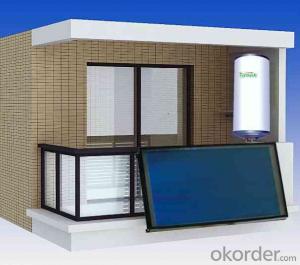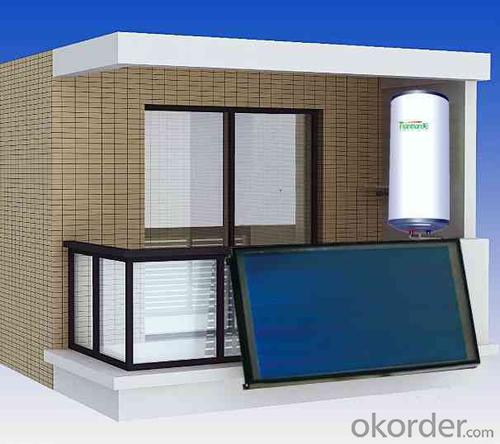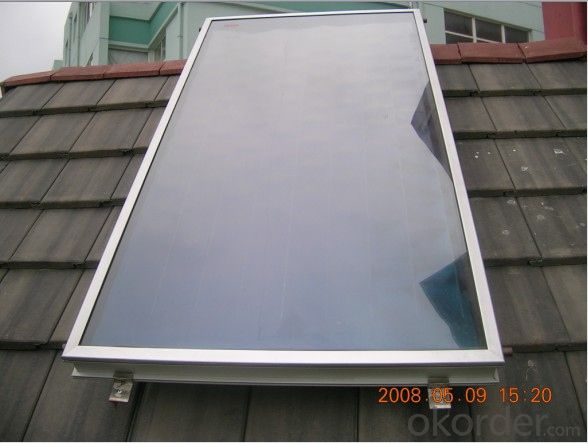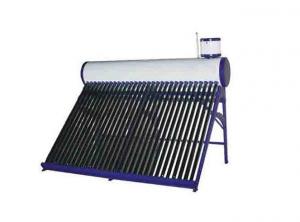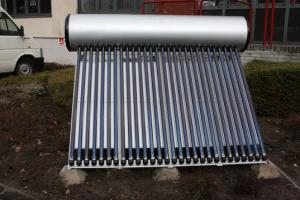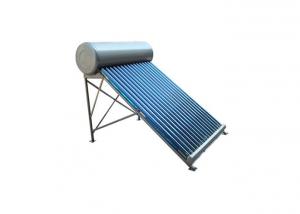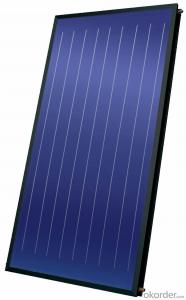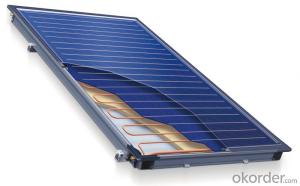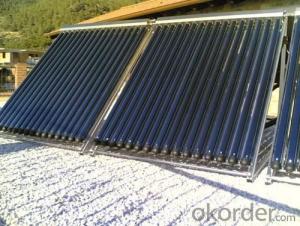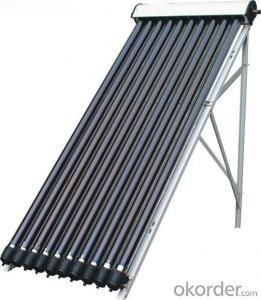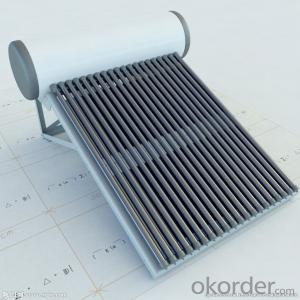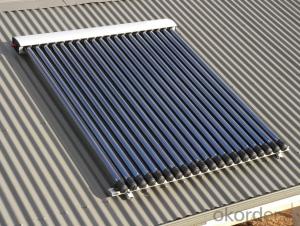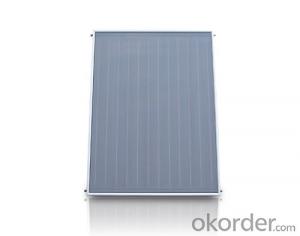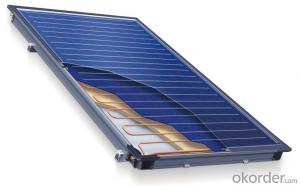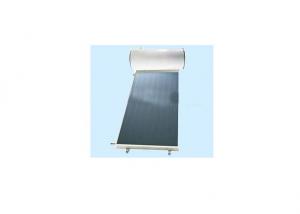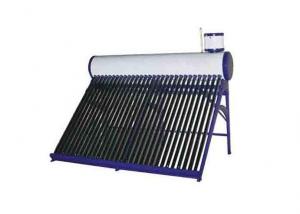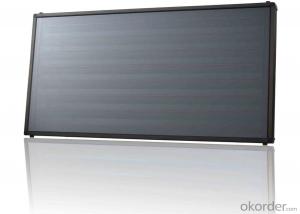Nobel Solar Collectors - Heat Pipe Vacuum Tubes Solar Thermal Collector with Most Reasonable Price
- Loading Port:
- Shanghai
- Payment Terms:
- TT OR LC
- Min Order Qty:
- 500 pc
- Supply Capability:
- 10000 pc/month
OKorder Service Pledge
OKorder Financial Service
You Might Also Like
Heat Pipe Vacuum Tubes Solar thermal collector with most reasonable price China manufacturer : The heat pipe series of solar collectors are always connected with existing heating supply device. The selective coating on the inner glass of the evacuated tube converts solar energy into heat energy and transfers heat to the heat pipes by aluminium fins. The liquid in the heat pipe changes into vapour and rises to the condensation end .The heat passes through the heat exchanger into the inner wall of the vacuum tube and then transfers through the copper pipes into the liquid..The transference of heat into the liquid creaters a continuous circulation as long as the collector is heated by the sun.
FEATURE:
1. Workable at water pressure up to 0.6Mpa.
2.Possible to be connected with existing energy source.
3. Water tank may not be installed together the collector.
4.The pipeline is made of copper and conducted by heat transfer medium liquid. The vacuum tube does not take water.The coating is high strength stainless steel with air flow design ,which is furnished in good style.
5.Possible to withstand high pressure in working condition.
6.Module design, free combination to meet the demand of large water consumption.
Feature:
1,header pipe materia
2,manifold material:aluminum alloy
3,tube dimensions:l1500/47mm or 1800/58
4,vacuum tube coating material:AL-N/AL or AL/N-SS-Cu
5,insulation layer:compressed rock wool
6,test pressure:9bar
7,working pressure:6bar
8,collector mounting:flat roof/inclined roof
9,angle of operation:5 degree-90degrees
10,heat preservation:72 hours
11,hail resistance:25mm
12,copper heat pipes for rapid heat transfer
Primary competitive advantages:
1 ISO,CE,SOLARKEYMARK
2 reasonable price and good quality
3 prompt delivery
4 environmental protection
5 OEM order is available
6 experience of export to 70 countries
7 international quality warranty:10 years for solar cillector and 15 years for vacuum tube
8 runner :copper runner 35mm, 40mm, 42mm
- Q: How much electricity can a solar collector generate?
- The amount of electricity a solar collector can generate depends on various factors such as its size, efficiency, location, and weather conditions. On average, a standard solar collector can generate enough electricity to power a household or small business. However, larger and more efficient solar collectors can generate even more electricity, potentially supplying excess energy to the grid.
- Q: How do solar collectors affect the environment?
- Solar collectors have a positive impact on the environment as they produce clean and renewable energy without emitting greenhouse gases or other pollutants. They help reduce our dependence on fossil fuels, mitigate climate change, and improve air quality. Additionally, solar collectors occupy minimal space, allowing for land conservation and biodiversity preservation.
- Q: What is the average payback period for a solar collector installation?
- The payback period for a solar collector installation can differ based on several factors, like the system's size and type, location, local energy prices, and available incentives. Typically, it ranges from 5 to 15 years. The payback period represents the time required to recover the installation's cost through energy savings. Solar collector installations are renowned for their long-term financial advantages, as they significantly reduce or even eliminate electricity bills by utilizing renewable solar energy. Various factors can reduce the payback period, including beneficial local policies and incentives like tax credits or rebates, high electricity prices, and abundant sunlight. Furthermore, technological advancements have resulted in more efficient and affordable solar collectors, further shortening the payback period. It is crucial to note that although the initial investment for a solar collector installation may be higher compared to traditional energy sources, the long-term savings and environmental benefits justify it as a worthwhile investment. Additionally, as the cost of solar technology continues to decline and energy prices increase, the average payback period is expected to decrease, making solar collector installations even more financially viable in the future.
- Q: Can solar collectors be used for heating religious buildings?
- Yes, solar collectors can be used for heating religious buildings. Solar thermal systems can be installed on the roofs of religious buildings to harness the sun's energy and convert it into heat. This heat can then be used for space heating, water heating, or both, reducing the reliance on traditional heating methods and resulting in cost savings and environmental benefits.
- Q: What is the maintenance cost of a solar collector system?
- The maintenance cost of a solar collector system can vary depending on various factors such as the size of the system, the type of collector, and the location. Generally, the maintenance cost is relatively low as solar collectors have few moving parts and require minimal upkeep. Regular inspections, cleaning of the collector surface, and occasional replacement of parts may be necessary, but these costs are usually minimal compared to the potential energy savings provided by the system.
- Q: Can solar collectors be used for heating livestock facilities?
- Solar collectors can indeed be utilized to heat livestock facilities, offering a sustainable and cost-effective solution for their heating needs. By installing solar water heaters or solar air heaters, the sun's energy can be harnessed and converted into heat, which can then warm the air or water within the facilities. This creates a pleasant and healthy environment for the animals. The use of solar water heaters in livestock facilities has a multitude of purposes. It can provide hot water for cleaning, sterilizing equipment, and even for the animals to drink. On the other hand, solar air heaters can ensure that the temperature inside the facilities remains suitable for the animals, particularly during colder months. Employing solar collectors for heating livestock facilities carries numerous advantages. Firstly, it diminishes reliance on fossil fuels, contributing to a more sustainable and environmentally friendly operation. Secondly, it significantly reduces heating costs due to the abundance and cost-free nature of solar energy. Additionally, solar heating systems necessitate minimal maintenance and boast a long lifespan, making them a reliable and durable solution. Nevertheless, it is crucial to consider the specific requirements and size of the livestock facility when planning to install solar collectors. Factors such as the number of animals, facility size, and local climate must be taken into account to ensure that the solar heating system is appropriately sized and designed to meet the heating demands. Seeking the guidance of solar energy experts or professionals in the field can aid in the design of an efficient and effective solar heating system for livestock facilities.
- Q: Are there any noise concerns associated with solar collectors?
- There can be minimal noise concerns associated with solar collectors. While the operation of solar panels themselves is silent, some systems may produce a low humming noise due to the movement of fluids or fans. However, this noise is typically very faint and not considered a significant concern for most homeowners or surrounding areas.
- Q: Are there any restrictions or regulations for installing solar collectors in certain areas?
- In certain areas, it is possible to encounter restrictions or regulations when it comes to the installation of solar collectors. These restrictions can differ based on the regulations and local government in place. Some common limitations include zoning laws, building codes, and rules set by homeowner associations. For instance, zoning laws might stipulate where solar collectors can be placed, including setbacks from property lines or height limitations. Building codes may demand specific permits or inspections to ensure the safety and structural integrity of solar collector installations. Homeowner associations could also have their own regulations pertaining to the visual appeal and positioning of solar collectors. Furthermore, certain regions might have unique regulations in place for historic districts or protected landscapes, which could limit the installation of solar collectors. Therefore, it is crucial for individuals or businesses interested in installing solar collectors to conduct thorough research and grasp the specific restrictions or regulations applicable to their area prior to proceeding with the installation process.
- Q: Are solar collectors suitable for agricultural greenhouses?
- Yes, solar collectors are suitable for agricultural greenhouses. They can provide a cost-effective and sustainable source of energy for heating, cooling, and lighting in greenhouses, thereby reducing dependency on traditional energy sources. Solar collectors can help create a more environmentally friendly and energy-efficient environment for growing crops in agricultural greenhouses.
- Q: Can solar collectors be used for generating electricity on data centers?
- Yes, solar collectors can be used for generating electricity on data centers. Solar collectors, also known as solar panels, convert sunlight into electricity through the photovoltaic effect. They consist of multiple solar cells that capture the sun's energy and convert it into direct current (DC) electricity. This electricity can then be converted into alternating current (AC) electricity through inverters, which is the standard form of electricity used in most buildings and data centers. Data centers have a significant energy demand due to the extensive amount of computer servers and cooling systems required for their operation. By installing solar collectors on the rooftops or surrounding areas of data centers, a portion or even the entirety of their electricity needs can be met through solar power. This has several advantages. Firstly, solar energy is a renewable and clean source of electricity. By utilizing solar collectors, data centers can reduce their reliance on fossil fuels and decrease their carbon footprint, contributing to a more sustainable and environmentally friendly operation. Secondly, solar energy can provide a reliable and stable source of electricity. Data centers require a constant power supply to ensure uninterrupted operations. Solar panels can be integrated with battery storage systems, allowing excess energy generated during the day to be stored and used during periods of insufficient sunlight or high electricity demand. This enables data centers to maintain a consistent and reliable power supply. Thirdly, solar energy can offer cost savings for data centers in the long run. Although the initial investment for installing solar collectors can be significant, the operational costs of solar energy are relatively low. Once installed, solar panels have a lifespan of several decades, requiring minimal maintenance. By reducing or eliminating their dependence on grid electricity, data centers can potentially save on utility bills and achieve long-term cost savings. In summary, solar collectors can indeed be used for generating electricity on data centers. By harnessing the power of the sun, data centers can reduce their environmental impact, ensure a reliable power supply, and potentially achieve cost savings. As solar technology continues to advance and become more efficient, it is likely to become an increasingly popular and viable option for powering data centers.
Send your message to us
Nobel Solar Collectors - Heat Pipe Vacuum Tubes Solar Thermal Collector with Most Reasonable Price
- Loading Port:
- Shanghai
- Payment Terms:
- TT OR LC
- Min Order Qty:
- 500 pc
- Supply Capability:
- 10000 pc/month
OKorder Service Pledge
OKorder Financial Service
Similar products
Hot products
Hot Searches
Related keywords
